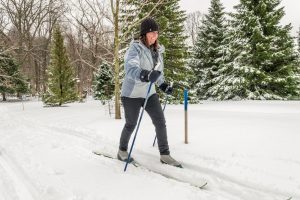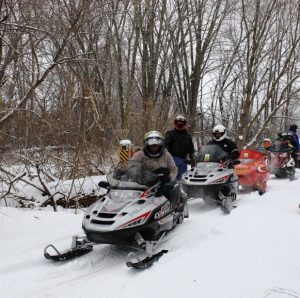Winter months big for outdoor recreation
January 21, 2022
While tubing is lower equipment maintenance than sledding, it still calls for being safe whether on a crowded hill or in a small group. (Photo courtesy of enjoyillinois.com)
January is a big month for winter sports recreation. Time to get moving again after the holiday season.
Winter sports can be a lot of fun, but the cold prompts the need to be properly dressed for the weather and to take extra care of the physical strain on your body.
Health officials also remind us to check winter sports equipment to be in good condition.
Here are some safety reminders before enjoying outdoor activities this winter.
(SOURCES: Illinois Department of Public Health, Centers from Disease Control and Prevention, Illinois Department of Natural Resources and Girl Scouts of America).
Sledding
A sled, especially if children are to use it, should have these safety features according to the IDPH:
- secure handholds,
- no protruding rivets or sharp edges,
- a bumper or guard over the metal front bar,
- no split or splintered wood or plastic,
- no bent metal parts,
- sled runners that curve around to the top and connect with the side rails, and
- sharp runners free from rust.

Illinois parks offer many places to enjoy cross country skiing, a winter activity that offers good exercise benefits for all ages.
Follow these safety guidelines when sledding:
- Look over the area where you will be sledding. Remove any debris from the slope and note the locations of any bumps. Know how to steer clear of ditches or trees.
- Know how to safely stop the sled or get off a moving sled in case of an emergency.
- Do not sled on roads or near traffic, particularly on hills that end in a street.
- Tubing calls for virtually no skill, balance or coordination—but it provides a whole lot of fun for family day out, or a group of friends with safety in mind.
Ice Skating
Make sure your skates fit well. Skates that are too loose can make it difficult to keep your balance, but If they are too tight, they can interfere with circulation.
If you skate on a lake or a pond, take additional safety precautions:
- Do not skate unless the ice has a uniform thickness of at least 4 inches.
- Have rescue devices, such as a rope, ladder and blankets, on hand.
- Do not skate alone.
(Check out these top areas around Illinois for ice skating: https://www.enjoyillinois.com/plan-your-trip/things-to-do/activities/ice-skating-in-illinois/)

Wearing skates that have a proper fit makes a big difference in ice skating safety.
Skiing
Check for these CDC safety factors for your ski equipment:
- Be certain boots fit snugly but are not tight enough to interfere with circulation.
- Purchase ski bindings at the same time you buy boots to avoid a mismatch.
- For beginners, use short skis and take lessons from a qualified instructor.
For downhill skiing, follow these safety rules:
- Never ski alone.
- Give skiers below you the right-of-way.
- Stop on the side of a ski run, not in the middle. Stay out of the way of skiers coming down behind you.
- Wear bright colored clothing so other skiers can spot you easily.
- Before passing another skier, shout “On your left” or “On your right.”
- On a lift or tow, carry your poles by the shafts.
For cross-country-skiing, here is some basic gear needed:
- Windproof, waterproof jacket
- Thick, water-resistant gloves or mittens
- Heavy insulating socks
- Thermal underwear
- Sunglasses or ski goggles to protect eyes from sun and snow glare
- Water bottle, high-energy food (such as fruits and nuts
- Sunscreen, and lip balm
- Cross country skis and poles and boots for cross country skis.
(For a glance at some of the top cross country ski locations in Illinois, go to

The Illinois Department of Natural Resources offers a snowmobile safety course and state laws set age limits on who can operate the machines. (Photo courtesy of Rockford Park District)
Snowmobiling
As snowmobiling grows in popularity, it is important to keep in mind these safety factors.
In Illinois, no person under 10 years of age may operate a snowmobile. Age 10 years and less than 12 years of age may operate under a parent or guardian’s direct control.
State law requires persons at least 12 years of age and less than age 16 may operate a snowmobile only if:
- they have in possession a valid Snowmobile Safety Education Certificate of Competency issued by the Illinois Department of Natural Resources, Safety Education Section;
- or they are accompanied on the snowmobile by a parent or guardian or person at least 16 –years-old and designated by a parent or guardian.
The Illinois Snowmobile Education Course is a minimum eight hours of instruction. These courses cover the basics in maintenance and repair of snowmobiles, proper and safe operation, history of snowmobiling, first aid, protection of the environment and the state laws.
Persons 12 and over completing the minimum eight hours of instruction and successfully completing the final examination will receive a State of Illinois Certificate of Competency.
Students between the age of 11-12 years old will receive their certificate upon their 12th birthday.

Snow shoeing is gaining in popularity and can be enjoyed by the whole family. (Photo courtesy of Cook County Forest Preserves)
Before leaving, IDPH warns to:
- Check the fuel and oil levels. Keep in mind your return trip.
- Make sure the headlights and taillights work.
- Test the emergency stop switch.
- Move the throttle to make sure it is not frozen in the “on” position and check the steering system to make sure it moves freely.
- Dress appropriately for the weather. Wear a helmet. Goggles are a must to protect eyes from branches, thorns, snow and cold. Scarves are not recommended because they may get caught in the machinery.
- Make sure someone knows where you are going and when you expect to be back. Never go alone.
Remember these safety rules:
- Be prepared for changing weather conditions.
- Be careful on ice and travel at low speeds.
- Do not travel on lakes or rivers without knowing the ice conditions. To be safe, there should be 8 inches of clear ice. It is best, however, to avoid snowmobiling on waterways all together.
- Snowmobiles are not built to carry passengers. If you do have a passenger, both persons’ feet should be kept on the running board. The person should lean with you when turning.
(For information on snowmobiling in Illinois, go to https://www2.illinois.gov/dnr/recreation/snowmobile/Pages/map.aspx)







